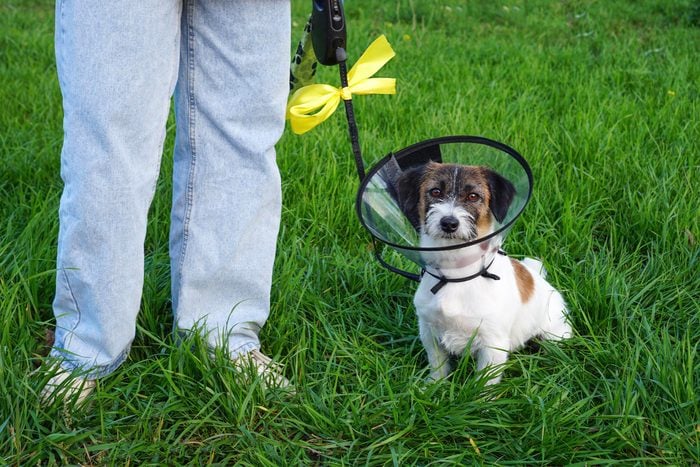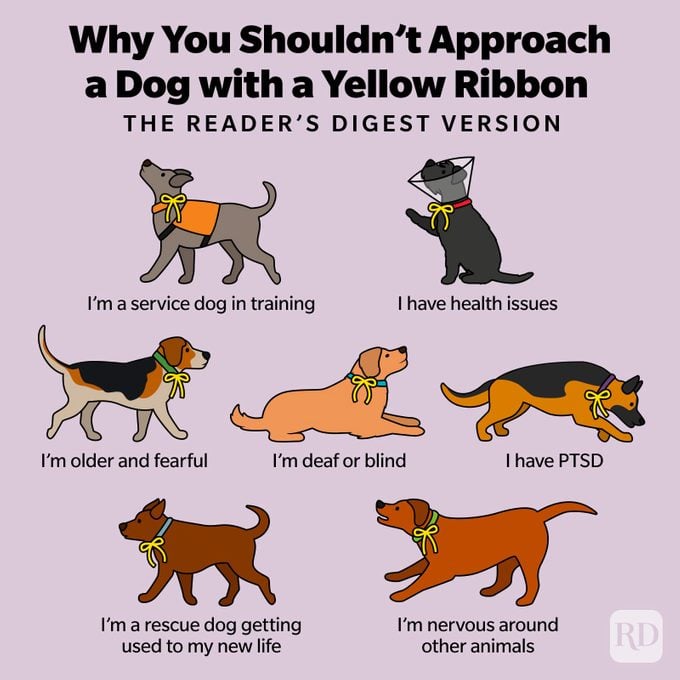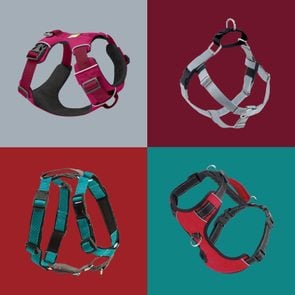If You See a Yellow Ribbon on a Dog Collar, This Is What It Means
Updated: Jul. 12, 2023

Why would a dog have a yellow ribbon on its collar? Hint: It's not a fashion statement. Here's what you need to know.
If you’re a dog lover, you’ve probably never met a dog you didn’t like. And if you’re a dog owner, you may be the parent of a playful, friendly pooch that wants to be buddies with every new dog they encounter. But dog facts are dog facts, and the fact is, no two dogs are alike. Some are playful, some are fearful, some are anxious and some aren’t as friendly as others. This could be their personalities, or it could be related to trauma, age or nerves. Fortunately, color-coded systems, like yellow ribbons on dog collars, help us decipher dog behavior.
“When a pet parent places a ribbon on their pet, they are looking to communicate with others and may be working to get their dog more comfortable in public or social environments,” says PetSmart training expert Jodie Havens. This system is a great way to indicate which dogs like to be petted by strangers or don’t mind being butt-sniffed by their canine counterparts, and which dogs need a little more space. Just like a red dog collar is a sign of an aggressive dog, a yellow ribbon on a dog collar or leash is a big clue as to that dog’s temperament. But what exactly is an owner or pet trying to tell you when it’s wearing a yellow bandanna or ribbon?

What does a yellow ribbon on a dog collar or leash mean?
For owners of skittish dogs, a yellow ribbon is an effective way to communicate with others that this pup needs some space to feel safe and protected, even when out for a walk. A yellow ribbon signals that the dog is most likely fearful or anxious, which might make him snappy with people or pets, and thus, should not be approached.
“Fear of other people or pets is one of the biggest reasons a dog may need more space,” Havens says. Dog anxiety that results in a dog being scared or aggressive could stem from a number of issues. “It could be a lack of early socialization, a lack of enrichment or even a previous history of punishment or previous negative conditioned emotional responses. These issues could make a dog more reactive or aggressive toward others, as most reactivity or aggression stems from fear.”
The dog with a yellow bandanna or yellow ribbon on its dog collar might be a(n):
- Traumatized rescue dog that’s still getting used to life with its new family and environment
- Older dog whose senses are dulled and is thus more fearful
- Deaf, blind or otherwise sensorially compromised dog
- Dog that’s been attacked by another dog and has PTSD
- Dog with health issues that cause it pain when touched
- Nervous dog that’s skittish on a leash and around other animals and humans
- Service dog in training that needs minimal distractions
Is a dog with a yellow ribbon dog collar aggressive?
A dog with a yellow ribbon won’t necessarily be aggressive. But its fearfulness or anxiety may lead it to cower, growl or try to flee, any of which could create havoc in a dog park. It might also have “fear aggression,” which is aggressive behavior, including barking, snarling and biting that manifests when the dog feels cornered or threatened and can’t remove itself from the situation.
Why did people start putting yellow ribbons on dog collars and leashes?
In North America, the practice of putting a yellow ribbon on dog collars began with the Yellow Dog Project, a movement to help nervous, flighty dogs and their owners. Dog trainer Tara Palardy was a driving force behind the movement because as a trainer, she saw the need for a way for owners to communicate from a distance that their dog didn’t want to be approached. The yellow ribbon or bandanna is visible to individuals who might otherwise approach the dog to play with or pet it.
What to do if you see a dog with a yellow ribbon
The purpose of a yellow ribbon dog collar is to communicate to others that this dog needs its space. So if you see a dog with a yellow ribbon or bandanna, your job is to avoid it. “Respect the space they need,” says Havens. “Go about your business, but avoid eye contact with the dog, slightly turn your body away from the dog and avoid speaking to the handler. These small changes can make a big difference.”
If you’re walking your dog on a leash and you encounter a yellow ribbon dog, just swing a wide berth—let the dog pass with at least several feet between it and your dog. “Do not move closer to the dog, stare at them or try to interact or pet the dog,” says Havens. “Also, do not let your dog approach them, and don’t try to start a conversation with the handler, as this could be triggering.”
If a dog with a yellow ribbon should approach you, Havens says to stay calm. “Slowly turn sideways and move away,” she says. “If you have your dog with you, slowly make a U-turn and calmly move away. Try to prevent your dog from staring by luring him or using cues like a hand target to redirect eye contact.” If your dog is off-leash at the dog park, call it before it can run up to greet the yellow ribbon dog.
And remember: No matter how much you love dogs, no matter how well versed you are in dog behavior and dog facial expressions, don’t think that you or your dog are the exception and that the dog with the yellow ribbon will warm up to you. Chances are that the owner is already anxious about taking their dog out in public and they’re trying to work on its fear issues. It’s not your job to break the dog’s pattern. Be respectful of the dog and its owner, and just leave them alone.
Next, find out why dogs sploot, according to veterinarians.
Sources:
- Jodie Havens, CPDT-KSA, training expert at PetSmart
- ASPCA: Common dog behavior issues: Aggression
- AKC Pet Insurance: The Yellow Dog Project



